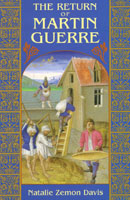
The Return of Martin Guerre
by Natalie Zemon Davis
How do we know what we know about history? At some point all of us ought to have wondered how we know what we know about what happened in the past.
I first wondered about this concept one day back in 2005 while listening to a story on NPR in which the interviewee, a university professor, repeated, almost off the cuff, the oft heard statement that in the middle ages life expectancy was somewhere in the mid 30 year range. I had recently read a Psalm that said the lifespan of a man was 70 years, 80 if he is strong. It occurred to me that the biblical account sounded pretty close to our modern life expectancy. Which was correct? And what happened in the more than 2,500 year interim to make people accept the modern short-life-span narrative?
That day I started looking through the historical literature to figure out how we know what we know about history and life expectancy. It turns out that when controlling for infant mortality, even in the midst of war, life expectancies were astonishingly consistent throughout the centuries. We know that from contemporary records of the day, records far more numerous than we allow ourselves to imagine today. In most of Europe, peoples’ births, weddings and deaths were recorded by their local parish. Yet today we can’t imagine that people kept detailed records because we have built up fictional narratives about what our predecessors must have been like rather than reading the actual accounts.
Natalie Zemon Davis takes the detailed records of court proceedings in a famous case in 16th Century southern France in which a woman and her identity-stealing partner were put on trial for adultery after an imposter walked into town claiming to be her husband after years away fighting in wars. The story itself would make a great novel, and in fact, was made into a well-known film starring Gerard Depardieu. More amazing is that the events actually happened. More amazing yet, to most of us who glory in our modern progress, is that these people of the 1500s cared enough to have not one, but two contemporary accounts of the case written by court scribes. And it isn’t just Davis who finds these treasures. Carlo Ginzburg produces another brilliant account of a trial in Italy in the late 1500s in The Cheese and the Worm. Both books present detailed and very credible evidence of what life was like and how educated average people were or weren’t.
From these medieval court accounts, Davis pieces together an image of contemporary life and what people thought about their lives and the world. She presents a vigorous defense of the bride in her history and makes you wonder how these people could have been so simple.
To that bold leap of inference, Robert Finlay responded to Davis’s work in the American Historical Review with a stinging criticism entitled “The Refashioning of Martin Guerre.” Finlay did not dispute any of the historical references or the records of the trial as proposed by Davis. Instead, Finlay critiques Davis for inserting modern-day social narratives to explain away how Martin Guerre’s wife could potentially mistake a man who looked nothing like her husband for the original item. THAT is where the genius of Finlay’s effort lies. We forget that we have a detailed historical record of actual events. We get into factual trouble when we ascribe not the facts, but the motives behind the facts to people whose true motives are hidden to posterity.
G.K. Chesterton addressed this exact issue in his short story “The Hole in the Wall” in his book The Man Who Knew Too Much. Chesterton refers to “one of the tricks of the modern mind, a tendency that most people obey without noticing it.” This tendency sees our forebears as quaint but intellectually inferior people whose stories are interesting to listen to, but certainly not to be trusted. Chesterton says “Modern intelligence won’t accept anything on authority. But it will accept anything without authority.” He writes of a fictional district in England called Holiwell (Holy Well), but spelled Holinwall. Moderns infer that since there could not possibly be such a thing as a holy well at a priory, the peasants must have meant that there was a hole in the wall of a country estate owned by a Mr Prior. But in fact, the land was at one time a priory with a well and that is where the murdered body would be found. Chesterton was more than half a century ahead of Finlay in critiquing those who assumed our ancestors couldn’t be trusted with their narratives and that we should adjust the facts to align with our inferences.
So how do we know what we know? First, we look for the detailed histories that are available. Then we very carefully make our inferences and make clear the distinctions between the two. To this end Natalie Zemon Davis makes a great contribution to our own knowledge of what the past offers us. Read both the book and the critique. You’ll be happy you did and hopefully look differently at the past and those good people who lived in it.
And if you are a business or government leader, ask the hard questions to your people. Ask them how we know what we know. Ask for the evidence. There are times when we must make inferences. Just make sure they are supported by what we really know, not what “everyone knows.”
Keep thinking…

Leave A Comment